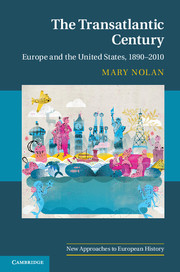Book contents
- Frontmatter
- Contents
- Illustrations
- Maps
- Tables
- Acknowledgments
- Introduction
- 1 An uncertain balance, 1890–1914
- 2 World War I: European crisis and American opportunity
- 3 Ambivalent engagement
- 4 The depression and transatlantic new deals
- 5 Strange affinities, new enemies
- 6 From world war to Cold War
- 7 Cooperation, competition, containment
- 8 Culture wars
- 9 The American Century erodes, 1968–1979
- 10 Renewed conflict and surprising collapse
- 11 A widening Atlantic
- 12 Imperial America, estranged Europe
- Suggested readings
- Index
- References
5 - Strange affinities, new enemies
Published online by Cambridge University Press: 05 November 2012
- Frontmatter
- Contents
- Illustrations
- Maps
- Tables
- Acknowledgments
- Introduction
- 1 An uncertain balance, 1890–1914
- 2 World War I: European crisis and American opportunity
- 3 Ambivalent engagement
- 4 The depression and transatlantic new deals
- 5 Strange affinities, new enemies
- 6 From world war to Cold War
- 7 Cooperation, competition, containment
- 8 Culture wars
- 9 The American Century erodes, 1968–1979
- 10 Renewed conflict and surprising collapse
- 11 A widening Atlantic
- 12 Imperial America, estranged Europe
- Suggested readings
- Index
- References
Summary
European-American relations in the crisis decade were reshaped not only by the depression and responses to it but also by the surprising reception of economic Americanism in the Soviet Union and Nazi Germany. In much of Western Europe, the depression tarnished America’s reputation as a nation of unrivaled prosperity, unlimited growth, and unequivocal modernity. Indeed, America seemed to be becoming Europeanized with its poverty, financial crises, class conflicts, and rising labor movement. As many Europeans slyly quipped, America was now “the land of limited opportunities.” Yet, for all its problems, America remained a model of economic modernity among regimes highly critical of its political system and cultural values. Nazi Germany, Fascist Italy, and the Soviet Union did not wish to emulate its production methods and consumer culture wholesale, but wanted to appropriate elements of them selectively, as they tried to define distinctive national versions of a rationalized, productive economy, mass consumption, and mass culture.
Italy and Germany sought to harness their transatlantic borrowings to expansionist foreign policies that once again raised the danger of war in Europe. The Soviet Union deployed its borrowings to bolster the communist project about which the United States remained as ambivalent as ever. The actions of all three nations forced the United States to ask who was its friend, who its enemy, questions that proved difficult to answer. Why did communist and fascist countries seek to emulate the American economic model and how did they modify it beyond recognition? Did the exchange of loans, technology, consumer goods, and people bring America closer to Germany, Italy, and the Soviet Union, or did widening political differences drive them further apart? Why did Americans, as well as the British and French, have such difficulty recognizing the threat posed by National Socialism?
- Type
- Chapter
- Information
- The Transatlantic CenturyEurope and America, 1890–2010, pp. 131 - 153Publisher: Cambridge University PressPrint publication year: 2012

